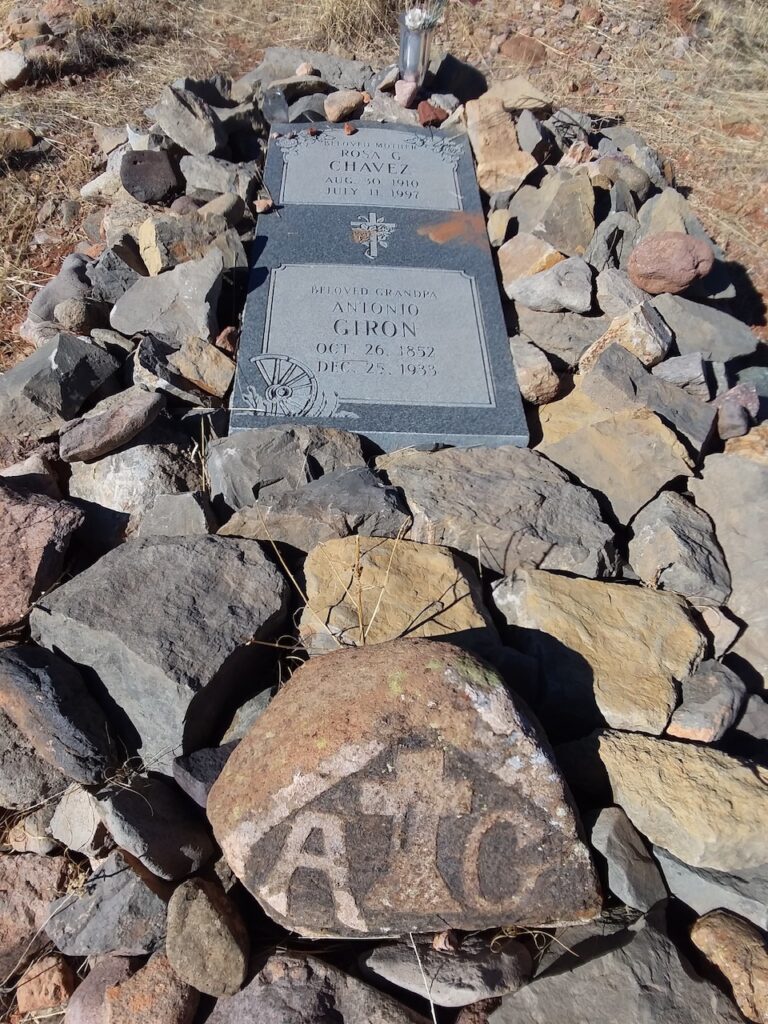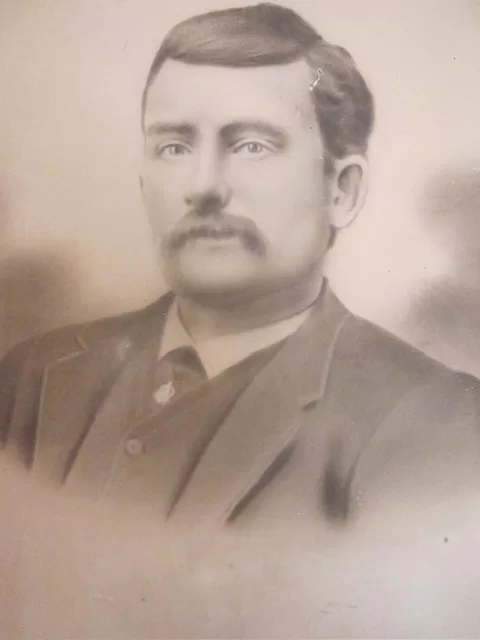Hillsboro Cemetery
What we know about the
Hillsboro New Mexico Cemetery
On this page find:
~ Stories we know of people buried in the Hillsboro cemetery.
~ A detailed spreadsheet and map to the graves for the Hillsboro Cemetery known at this time.
If you have information about any person or family in the cemetery, please contact us to share your information. Every story is important to more understanding of our area’s history. We thank you!
Please contact us at hillsboronmhistory@gmail.com
Selected Stories from Hillsboro
Francisco M. Bojórquez ~ 1865-1920

Francisco “Frank” M. Bojórquez (1865-1920) was born in San Bernardino, California, in 1865, but was raised and learned his cowboying skills in Sonora, Mexico. He came to New Mexico in 1888 and worked on various ranches, including what was to become the Ladder Ranch. He often served as foreman and by 1900 bought his own ranch on Palomas Creek. His actions and expertise as a cowboy, especially in roping, became legendary.
Bojórquez served many years in public office and was a dedicated supporter of the Mexican-American community. He was elected precinct constable in 1895 and the following year was elected to the Sierra County Commission and served as a commissioner for nine years. In 1914 he was twice elected as Representative to the state House, but was denied admission by the Republican majority. He was twice elected Sheriff of Sierra County but died of appendicitis in 1920 during his second term. Cemetery Map C11, 34


Charles C. Crews ~ 1829-1887
Charles Constantine Crews (1829-1887) was born into an upstanding family in Upson County, Georgia. He studied law and medicine and graduated from medical school in Louisiana. In 1862 he joined the Confederate Army as a captain. He fought in many campaigns, was once captured and later exchanged, and was twice wounded in other battles. He was promoted to Colonel and recommended for promotion to Brigadier General.
When the Civil War ended, he practiced medicine and was a railroad executive. In 1875 he moved with his family first to Texas and then to New Mexico in 1879, where he settled in Gold Dust initially and moved into Hillsboro where he supposedly built the first house, a still-occupied adobe just across the street from the present Post Office. Here he practiced medicine until his death from pneumonia in 1887. Cemetery Map C3, 20

Daniel Dugan 1834-1884 & David Stitzel 1839-1914



Daniel Dugan (1834-1884) and David Stitzel (1839-1914) were members of the California Column that came to New Mexico in 1862 to counter the Confederate intrusion. They wound up mining in the Silver City area. Then in 1877 they explored the east side of the Black Range and made the gold strike just northeast of Hillsboro that made them known as the “fathers of Hillsboro.”
Dugan became quite wealthy making and selling mining claims. He had impregnated a woman in Scotland but was not allowed to marry her. In a historically romantic turn, he brought his biological son, Thomas Ingles, to the U.S. Dugan lived only long enough to see Sierra County created with Hillsboro as the county seat in 1884. Ingles inherited his father’s ranch in the Lake Valley area where he became well-known. Cemetery Map C2, 24.
Stitzel (sometimes spelled Stitsel or Stitsell) lived longer but did not prosper so well. He homesteaded in San Lorenzo. He was convicted of killing a man in an argument over a plow in 1884. He died in Hillsboro just months after marrying his second wife. Cemetery Map C16, 18.
Antonio Giron ~ 1852 -1933

Antonio Girón (1852-1933). We know too little about the man of this new and elegant double grave stone that has a rock marker at the base carved with the initials A G on each side of a cross. In the 1930 U.S. Census we find Antonio Girón listed as living in Hillsboro, age 74, and born about 1856. A death record on Ancestry.com gives a death date of December 24, 1931, and identifies his wife as Consuela González Girón. The 1930 census shows he had six children, the fourth of whom was Rosa Girón, the mother at the top of the double marker who married a Chávez.
A related note of interest is that his widow and one of his sons joined Sadie Orchard in filing an injunction in 1936 to stop the transfer of the county seat to Hot Springs.
The carved rock at the base stood alone until at least 2009; it may have been the original marker for Antonio or perhaps for a daughter, Anita, who died at nine years of age in 1914. (C20, 3)
George T. Miller ~ 1866 - 1909
George Tambling Miller (1866-1909), a native of Minnesota who was employed there in his father’s hardware store, decided to venture out and come by train to New Mexico in 1893 with his wife Ninette and baby daughter. Aided by his prosperous brother-in-law Nicholas Galles, he worked in several business capacities until buying Hillsboro’s drugstore (now the General Store Café) in 1902. Since his daughter died at just 18 months old, he had only one other child, George Albion, born in 1904. Geoge Tambling Miller died suddenly of appendicitis in 1909 and was apparently buried with only this carved stone as a marker. His wife continued to run the drugstore, and his son later operated it as a general store until others converted it into a cafe. (location of stone uncertain)


Demeteria Muñoz ~ 1890-1918

We know very little about the Demeteria Muñoz (1890-1918), the young mother honored by this substantial memorial. A 1907 issue of the local newspaper, the Sierra County Advocate, tells us that a marriage license was issued for 18-year-old (lamentably misspelled) Dementria Vega and Pablo Munos (a typical surname spelling). Beyond this we know nothing. There is the grave of Claro Muñoz (died in 1906) many rows to the west but we don’t know of any relationship. We have only minor notes on others with the Muñoz name. A 1913 notice in the local newspaper reports that “Manuel Munoz died early this morning at his home on the Reservation,” which raises an intruguing possibility. A neighborhood of northwest Hillsboro on North Percha Creek was once known as “La Reserva” or the “Reservation.” Was this an Apache section of town? Perhaps Demeteria was Apache? Another significant observation is Demeteria’s death date; she was no doubt an early victim of the 1918 flu pandemic. Cemetery Map C17, 2
Thomas Murphy ~ 1848-1914

Thomas Murphy (1848-1914), a native of Maine, joined the Union Army at the age of 15 and continued in the military, serving a number of years in New Mexico until 1878. He first settled in Lake Valley, then Kingston, and finally Hillsboro. He became well-known for his military service and for having had a bar in each of the three towns. When Sierra County was created in 1884, the governor appointed him the county’s first sheriff. He was elected to a second term and later served as director of schools and a county commissioner. He married in 1893 and had one daughter, Nona. He was serving as patron of the Masons’ women’s auxiliary when the devastating flood of June 1914 roared through town. Attempting to get back to the eight women meeting on the second floor of the Masonic Hall, he was swept away and drowned, the only victim of that flood. His adobe home on Elenora Street still stands. Cemetery Map M3, 23


Hillsboro Cemetery Mapping

Explanation of the Hillsboro Cemetery Drone Map and Grave Sites
The Hillsboro Cemetery is located on the top of the hill south of town, just on the west edge of Highway 27. The Cemetery is divided into two sections, a Masonic section on the west (right side of photo) and a community section on the east. The two sections are separated by a chain-link fence, but the fence was added well after the rock-walled and wrought-iron-fenced Crews-Mauldin family plot was set in place. A glance at the map shows that the layout of the Cemetery is often chaotic. While the Masonic section has been arranged and controlled in a somewhat orderly fashion — and even regularly cleaned, the layout and care of the Community section is much more anarchic.
From Highway 27 an unpaved entry road runs along the north side of the Cemetery, which is lined by a chain-link fence that has five gates marked as red A-F on the map. We have attempted to label the north-south Rows of graves along the edge of this fence, numbering them from the west for the two sections, Masonic (M1, etc) and Community (C1, etc.). Like the roads or trails entering at each gate, the rows are not straight and often imaginary. We assume a maximum of roughly fifty possible graves per row, and for each known grave site on our list we assign a Location numbered by distance from the fence.
It may take some investigation to find an individual’s grave site using the Row and Location listed in our guide. To take an easy example, to find the grave of Thomas Murphy (M3, 23), enter Gate F and walk about halfway down the road (23 is about half of 50); looking to your right over one row, you’ll see his two markers. To find the prominent grave of Demeteria Muñoz (C17, 2) you would enter Gate C and immediately look to your right.
Finding the grave of Francisco Bojórquez (C11, 34) is more challenging. Entering Gate D, you will walk about two-thirds (34 is about two thirds of 50) of the way down the trail that seems to bend a bit to the left. Looking to your left about one row over you will spot the gray marble back side of his marker.
This gives you an idea of how to find a known grave site identified in our listing. You will find it gets more difficult to find locations with small and indistinct markers or flat stones or simply a name or initials carved in a rock. And exploring around, you will be shocked that our Cemetery contains so many unmarked, unidentified, and therefore unlisted graves.


For More Information
An excellent free website for extensive grave information and photos: https://www.findagrave.com/
